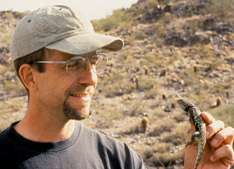What do toad toes show? Plenty, says ASU biologist

(PhysOrg.com) -- Brian Sullivan has been clipping toes from toads since the early 1980s. It’s not some type of strange hobby, and he releases the toads back into their habitat along the Agua Fria River north of Phoenix once he has obtained samples and collected data about the toads’ appearance.
The point of Sullivan’s work is to study interactions between two species of toads in central Arizona, and those toe clippings provide critical DNA samples. Sullivan is a professor of evolutionary biology and herpetology in Arizona State University’s New College of Interdisciplinary Arts and Sciences.
Specifically, Sullivan is examining cross-breeding, also known as hybridization, between the Arizona Toad and the Woodhouse’s Toad. His work provides evidence that human activity, such as dam construction, creates habitat changes that lead to hybridization between these two species. A variety of outcomes is possible following hybridization, but in some instances it can lead to the decline or extinction of one of the species.
“It has been hypothesized that the construction of dams, like Waddell Dam at Lake Pleasant, changes the aquatic habitat in favor of the Woodhouse’s Toad and to the detriment of the Arizona Toad,” says Sullivan, who earned his Ph.D. in zoology at ASU’s Tempe campus in 1983 and has taught at the West campus since 1989. “Because my data goes back to the 1980s, I can test this hypothesis by collecting new data and comparing it with data that pre-dates the 1994 expansion of Lake Pleasant.”
If hybridization between these toad species is due to local environmental factors, Sullivan says, the area in which hybridization is occurring should have shifted upstream as a result of the dramatic rise in the water level of Lake Pleasant in the 1990s.
Sullivan has begun gathering samples of toads at a number of sites along the Agua Fria River. Besides those toe clippings, he makes note of physical characteristics such as spotting and striping that help identify a toad as an Arizona, a Woodhouse’s, or a hybrid of the two. He will repeat this sample collection process during the spring of 2010.
“To increase our understanding of the evolutionary significance of hybridization, it’s important to study the dynamics of hybrid zones through time as well as among locations,” Sullivan says. “The fact that I have been collecting data on toads around the Agua Fria for such a long time gives us a great opportunity to conduct a thorough, long-term study of hybridization in relation to human-induced habitat change.”
Sullivan’s project involves collaboration with a colleague in Ohio. More than a decade ago, he and Terry Schwaner, dean of the College of Sciences at Findlay College, began coordinating their research on the two toad species. Following up on work Sullivan undertook from 1990 to 1993, Schwaner studied both species in the Virgin River of extreme southwestern Utah from 1998 to 2004.
Schwaner recently drove to Phoenix to pick up 400 of Sullivan’s toad tissue samples. The visit also gave Schwaner the chance to see the sites around the Agua Fria where Sullivan collects samples. It was the first time in their long collaborative relationship that the two scientists had met in person.
Schwaner returned to Ohio with the tissue samples packed in 50 pounds of dry ice. He and his colleagues at Findlay University will process the samples so that he and Sullivan can conduct DNA analysis.
For his part, Sullivan is hoping the project will attract governmental grant funding enabling continuation and expansion of the research activity. “Above and beyond the information gained regarding environmental change and its impact on these toads, long-term studies of hybridization can provide insights as to the nature of species boundaries and the process of species formation,” he says.
“This type of hands-on, basic scientific research is vital to our understanding of ecosystems and how human activity affects them,” says Roger Berger, director of the Division of Mathematical and Natural Sciences in ASU’s West campus-based New College. “When our students interact with professors who are engaged in work of this nature, it inspires a new generation of researchers to investigate important questions about our environment and how we affect it.”
Provided by Arizona State University (news : web)














